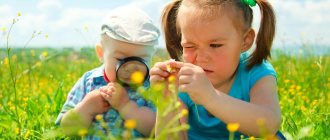CHILDHOOD GUIDE
Familiarization of preschoolers with the surrounding natural world is considered within the educational field “Cognitive Development” and provides for the solution of such tasks as: - the formation of primary ideas about living and inanimate nature; — education of a humane, emotionally positive, careful, caring attitude towards the natural world and the environment in general. The most important thing is that in the process of environmental education, children develop cognitive interest in the natural world, curiosity, creative activity, i.e., the child’s personal qualities, which are presented as targets in the Federal State Educational Standard for Education .
The most effective forms of interaction between a teacher and children in environmental education are considered to be those in which preschoolers have the opportunity to have direct contact with nature . In this case, children develop not only environmental knowledge , but also experience in using this knowledge in practical activities. Such forms of interaction include excursions, walks, experimentation, and observations.
You can download practical materials on environmental education for preschoolers (thematic planning, lesson notes, observations, etc.) on the “Library” website page, in the “Cognitive Development” section.
First of all, it is necessary to create conditions for obtaining environmental knowledge and its subsequent application. The group should be equipped with an environmental center , where children's and encyclopedic literature with natural history and environmental content, manuals for experimentation, observation diaries and other materials will be presented. On the territory of a preschool institution, it is desirable to create an experimental site, a weather station, an “ecological trail” so that students can conduct experimental research activities, observe the growth of various plants and shrubs, organize weather observations, and draw conclusions about the relationships and interdependencies in nature.
Various environmental events and projects will help shape the environmental culture of preschoolers. For example, campaigns for landscaping the territory of a preschool educational institution, garbage collection, and protection of trees on the site. Projects can be aimed at improving the site, helping wintering birds, developing the Red Data Book of the nature of the native land, creating toys from waste materials, etc. The names of actions and projects can be the following - “Green City”; - “We are responsible for those we have tamed”; - “Our little brothers”; — “Feed the birds in winter”; — “Mineral resources of our region”; - “Reservoirs of our region.”
The result of practical activities on environmental education for preschoolers can be considered: - creation of wall newspapers with stories about favorite pets; — writing stories about animals and plants, recommendations for caring for animals and plants; — development of presentations, photo reports, etc.
Dear teachers! If you have questions about the topic of the article or want to clarify some points in the work on environmental education, then write in the comments . I'll definitely help.
Golovina Bela Gennadievna, site administrator.
Environmental education of preschool children Federal State Educational Standards of Education: taking into account the ethnocultural situation of the development of preschool children Socio-economic education of preschool children Formation of environmental culture among preschool children >
Goals and objectives of environmental education in preschool educational institutions
Preschool age is a unique period in the formation and development of a child. A properly organized upbringing process has a productive effect on the overall development of the child and creates the prerequisites for his further upbringing and education.
Are you an expert in this subject area? We invite you to become the author of the Directory Working Conditions
The general goal of raising preschool children is the full, comprehensive and harmonious development of the child’s personality.
It is very difficult to identify a single goal of environmental education for preschool children, since environmental education is a continuous process that begins from preschool age and continues throughout life.
Note 2
According to the Federal State Educational Standard for Preschool Education, the goal of environmental education for preschool children is the implementation by preschool teachers of a continuous, purposeful, controlled process to develop an environmental culture in children.
Elements of ecological culture of preschool children are:
- respect for the environment
- sustainable knowledge about the surrounding world and the interconnection of all living things
- correct understanding of a “healthy lifestyle” (HLS)
- moral attitudes and ideas about environmental values
- emotional responsiveness to nature and its phenomena
- positive feelings and sensations from communication with the surrounding nature
- desire to explore and learn about the world around us
Finished works on a similar topic
Coursework The purpose and objectives of environmental education 420 ₽ Abstract The purpose and objectives of environmental education 220 ₽ Examination The purpose and objectives of environmental education 220 ₽
Receive completed work or specialist advice on your educational project Find out the cost
The goal of environmental education of preschool children, specified in the Federal State Educational Standard for Preschool Education, is achieved by solving its main tasks:
- Educational objectives:
- formation of a holistic system of knowledge about current environmental problems of the world
learning ways to solve environmental problems
- acquisition of knowledge on the prevention of environmental problems
- Educational tasks:
- formation of motives, habits and needs for environmental behavior
formation of a healthy lifestyle throughout life, a negative attitude towards bad habits
- development of the need for a healthy lifestyle and compliance with environmental rules of behavior
- Developmental tasks:
- development of a system of theoretical and practical knowledge, skills and abilities aimed at studying and assessing the state of the environment
development of skills to preserve and improve the state of the environment.
Goals and objectives of environmental education at school
Note 3
The main goal of environmental education at school is the formation and development of environmental culture and environmental competencies in children.
Environmental education of schoolchildren is aimed at transferring the environmental experience of the older generation. However, this is not always enough for environmental education to be complete and effective. In order to achieve this goal, the student must be an active participant in the educational process and influence his elders and peers.
It should be noted that the environmental goals of education at school are different, depending on the age of the children.
Goals of environmental education of children in primary school:
- fostering a caring and respectful attitude towards the environment
- development of a sustainable desire to observe moral principles in the process of relationships with nature and when using natural resources
- promotion of environmental goals
- engaging in active activities to study the rules of treating nature and how to protect it
The tasks of environmental education for primary school children are similar to the tasks of raising children in preschool educational institutions. However, in addition to educational, educational and developmental types of tasks, there are a number of specific tasks based on the age characteristics and needs of children of primary school age.
Objectives of environmental education in primary school:
- Educational and educational objectives: deepening and expanding existing environmental knowledge
- Behavioral tasks: developing initial environmental skills and abilities
- Cognitive tasks: development of cognitive, creative and social activity of children in the process of environmental activities
- Transformative tasks: aimed at fostering feelings of respect for nature.
Ecology
The key component of the concept of “ecology” is “interaction”, “connection”. Initially, since the time of E. Haeckel, who first introduced this term in 1864, and for a long time after that, ecology designated the field of knowledge about the connections of living organisms - plants, animals, their communities - with the environment, i.e. it was a section biology. Later, this concept began to expand to include humans.
At the present stage, ecology can be defined as a science that examines the relationship of living organisms, including humans, and their communities with the environment.
At the same time, the environment can be understood as both the natural environment and the environment as a whole (natural, social, material). In the first case, we talk about ecology in a narrow sense, in the second - in a broad sense.
In environmental education of children, as a rule, they are limited to ecology in the narrow sense, i.e. consider the relationship between man and the natural environment. And this is correct, otherwise the objects to which children’s attitudes are formed become blurred, and there are too many of them. And the environmental problem itself arose precisely because the natural environment began to be destroyed as a result of human activity.
So, the concept of “ecology” includes two components: nature as biological objects, as the natural environment and the connections between them. Consequently, preparing a preschooler for subsequent full mastery of ecology includes:
- a) the formation in children of ideas about objects of environmental interaction - objects of nature, and first of all about plants and animals (and this is natural science);
- b) the formation of ideas about connections, without yet dividing them into natural, environmental or other connections.
The study of relationships (cause and effect) in preschool education is currently receiving the necessary attention, but this is not always connected with environmental education. Whereas in the educational system “School 2100” this area of work is directly tied to it. As the authors of the textbook “Hello, World!” note, they begin environmental education with the idea formulated by ecologist Barry Commoner: “everything is connected to everything” [1]. And this is the beginning of the formation of an appropriate universal educational action, defined in the Federal State Educational Standard for primary education as “identifying cause-and-effect relationships.”
However, there is an aspect in the Federal State Educational Standard for Education that is directly related to environmental education. One of the tasks there is formulated as follows: “development of emotional and value perception... of the natural world.” This task is implemented within the framework of environmental education, since the formation and development of emotional and value relations towards nature belong to the sphere of environmental education. And an emotional-value attitude is possible if children have ideas (knowledge) about nature as something valuable, i.e. elements of environmental education should also be present here.




